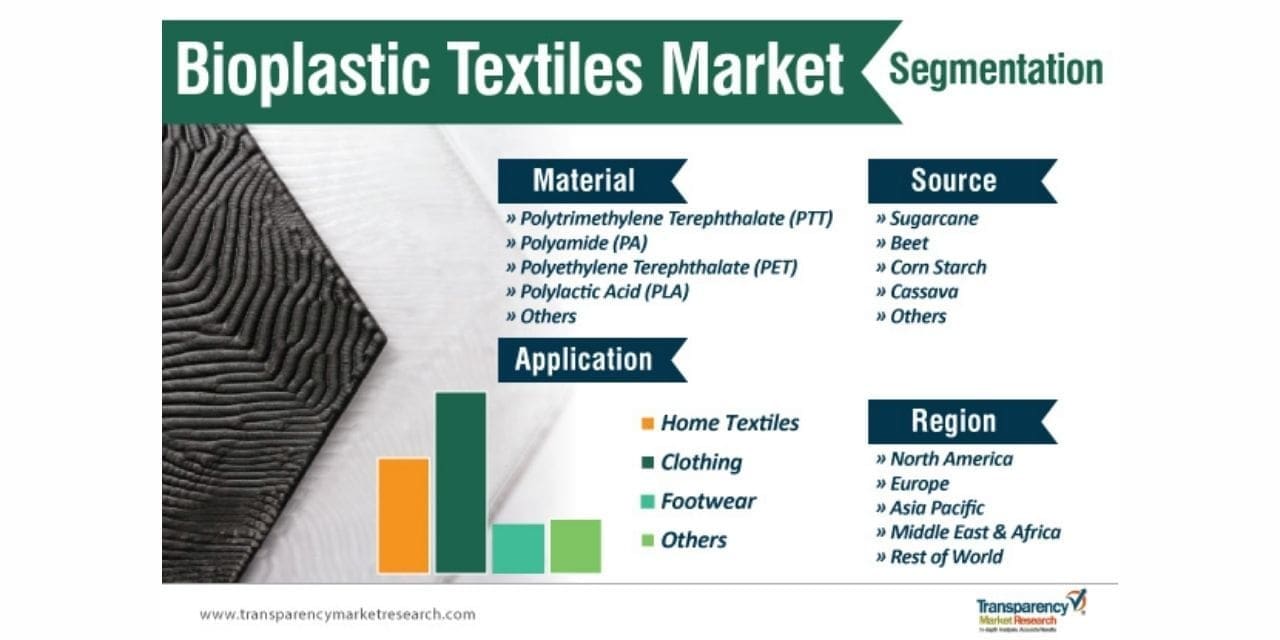Global Bioplastic Textiles Market: Key Highlights
- The global bioplastic textiles market was valued at ~US$ 440 Mn in 2018, and is anticipated to expand at a CAGR of ~12% during the forecast period.
- The global bioplastic textiles market is driven by the increasing demand for sustainable products among consumers.
- Europe accounts for a major share of the global bioplastic textiles market, led by the high demand for bioplastic textiles from clothing and automotive manufacturers.
Key Drivers of Global Bioplastic Textiles Market
- Bioplastic textiles are used in diverse applications, such as footwear, clothing, and other accessories. Producers of clothes and footwear have adopted bioplastic textiles, primarily due to climatic changes, volatile prices of petroleum, and high prices of natural gas, which is the key feedstock used in the production of synthetic plastics.
- Manufacturers not only incorporate bioplastic textiles into their products, but also promote their products as environmentally-safe. Thus, various initiatives by renowned brands are augmenting the demand for bioplastic textiles. Rain Poncho, produced by Spain-based Equilicua, is the perfect example of bioplastic protective coatings. This raincoat is produced from potato starch. Rain Poncho is non-toxic; it does not pollute the environment; and is 100% compostable and biodegradable. Moreover, the information printed on this raincoat informs the user about the benefits of bioplastic textiles and biodegradable materials.
- Gucci, a prominent company based in Italy, has developed eco-friendly men’s and women’s shoes made of bioplastic and biodegradable materials sourced from compost. Moreover, PUMA SE, a notable Germany-based player, has also started production of sneakers and shirts that contain biodegradable bioplastics. The upper part of PUMA’s sneaker base is made from cotton and linen blends, while the sole is made of bioplastics.
- Additionally, bioplastic textiles are largely used in the production of car interiors, seats, and other parts. If an average cars weighs 1,500 kg, it contains 15-20 kilograms of textile and textile components.
- Thus, the global market for bioplastics textiles is expected to expand during the forecast period, owing to rising demand from various textile manufacturers.
Polylactic Acid (PLA) to Witness Attractive Opportunities
- Polylactic acid (PLA) is a biodegradable plastic derived from agricultural sources such as sugarcane, potatoes, and tapioca roots. Due to its degradable nature, polylactic acid has several applications. It is completely degradable under compost conditions. Polylactic acid is used to obtain products with a long lifespan. PLA is available on an industrial scale, and its production does not require high initial investments and strict timelines, which are commonly associated with new polymers.
- Synthetic polymers depend on resources such as oil and gases for sourcing their monomers. These resources take millions of years to regenerate. On the other hand, bio-based fibers are obtained from natural renewable resources. PLA (polylactic acid) polymer is one of them. Polylactic acid is used in applications such as casual wear (men’s wear and women’s wear), protective clothing, and workwear clothing.
- Thus, increase in the demand for polylactic acid boosts the global market for bioplastic textiles.
Higher Prices than Conventional Textiles to Hamper Market
- The difference between the prices of petro-plastic and bioplastic textiles is high; however, in recent years, the prices of bioplastic textiles have been declining, while those of petro-plastic textiles have been increasing. The prices of bioplastic textiles are expected to decline in the near future, led by economies of scale and ongoing advancements in process engineering, while the production of petro-plastic textiles has reached the highest level of efficiency and maturity.
- The current production capacity for bioplastic textiles is significantly lower than that for conventional plastic textiles, which reduces the potential for their substitution and increases the price of the final product. Price consideration is anticipated to be a key factor hampering the global market for bioplastic textiles during the forecast period.
Asia Pacific Dominates Global Bioplastic Textiles Market
- In terms of volume, Asia Pacific held a major share of the global bioplastic textiles market in 2018. This trend is anticipated to continue throughout the forecast period, led by the high demand for bioplastic textiles in the clothing industry in the region.
- The bioplastic textiles market in North America is mature. The U.S. is a leading consumer of bioplastic textiles in the region. North America constituted 18.6% share of the global market in 2018.
- Increase in the demand for PLA and PTT in the region is the key factor driving the market for bioplastic textiles in Europe.
Top Three Players Hold 40% Share of Global Bioplastics Industry
- The global bioplastics industry is dominated by a small number of players. The top three players held ~40% share of the global industry in 2018. These players include Ercros S.A, BASF SE, and Natureworks LLC.
- Natureworks LLC accounted for ~18.% share of the global bioplastics industry in 2018. The significant share of the company can be attributed to its continuous focus on innovations, implementation of growth strategies, business expansion through strategic capital allocation, and extensive research & development activities.
- BASF SE is a leading manufacturer of bioplastics. The company constituted ~13% share of the global bioplastics industry in 2018. BASF SE aims at strengthening its position as a leading energy company. It is the largest producer of chemicals in the world.
- Other key players operating in the global bioplastics industry include DuPont de Nemours, Inc., NaturePlast, and FKuR Biome Bioplastics.

